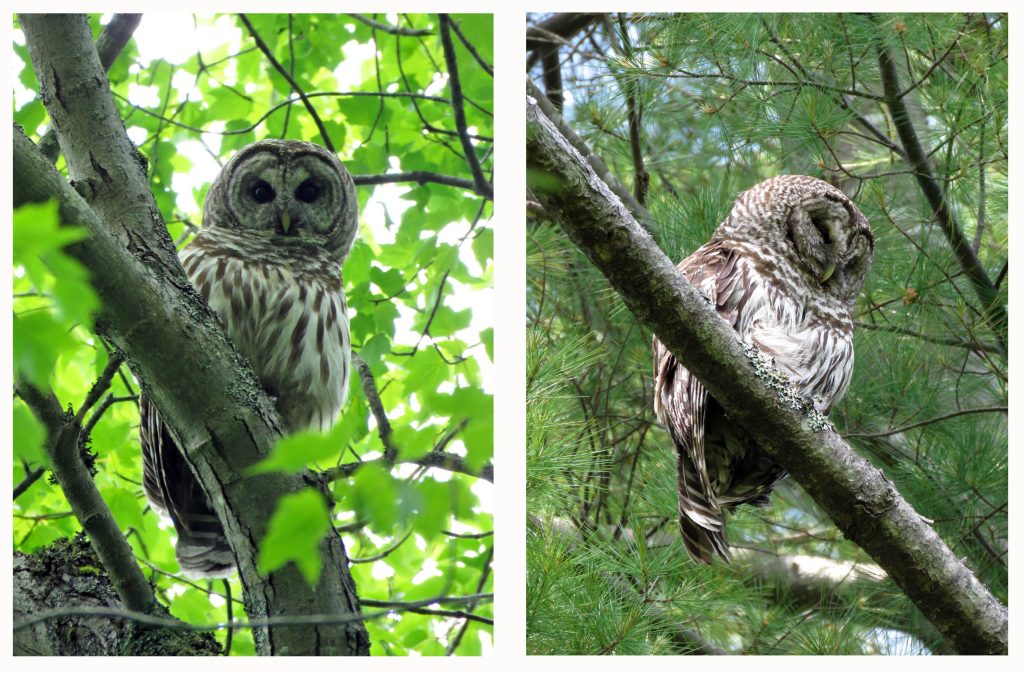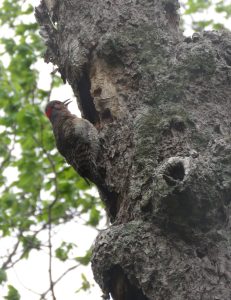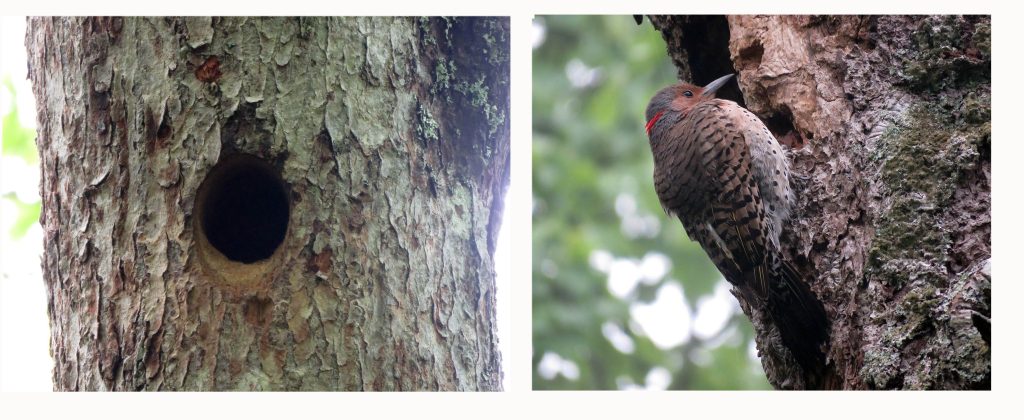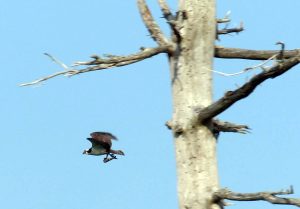
Hairy Woodpecker (female) on nest cavity May 28, 2024
All Photos on this page by Joshua Barss Donham
Click on images for larger versions
On Hairy Woodpecker & Flicker nests, Hermit Thrush and Barred Owl behaviour, Osprey fishing, Eastern Wood Peewee sighting, Common Nighthawk activity, a bird survey and sounds of toads and beavers in the night, late spring into early summer of 2024
Wrote Joshua Barss Donham on June 24, 2024:
I was away for the last few days of May and the first week of June, but the day before I left I visited the Hairy Woodpeckers Nest.
Everything was as it had been when Fulton and I checked it a couple of days before.
Parents were still visiting the nest cavity with food and the young still could be heard calling out to the parents for more food when the parents were out foraging.
Fulton and I had discovered a different trail, or trail branch, still within view of the nest cavity but further away and less obtrusive than the section of trail that passed right by the base of the nest tree, From this new vantage point I discovered that not 25 metres away from the Hairy’s nest tree, was a Northern Flickers nest!
The day after I got back all was quiet at the first site; the Hairy Woodpeckers had fledged. The Flicker’s nest, however, was busy with parents making frequent trips to and from the nest cavity.
For the Hairy Woodpeckers the nesting season is complete. The Black-capped Chickadees nesting at East Pine Island Pond were making none stop trips to and from their nest on June 12th when Fulton and I did a Bird Survey of that area.
Two days later, the young had fledged. For others nesting season was in full swing.
For some of these, last week Fulton and I met Siobhan (Siobhan and Madeleine are the two Dalhousie student collecting Nighthawk data in the Backlands this summer) who was out moving one of her bug traps from one location to another in the Colpitt Lake area.
Trading nesting bird stories, she told us of how, while she and Madeleine were hiking out the old road at the end of Princeton Ave to set out an insect trap, they had a singular experience when they were met by a family of Spruce Grouse (they saw the chicks and both parents). One of adult grouse would approach very close occasionally taking a little run at them, then feign an injured wing and try leading them off in the opposite direction as the chicks.
On a walk through the corridor between Colpitt and Williams Lake I came across a pair of Hermit Thrush who acted similarly, one trying to get my attention by coming very close, and then trying to lead me off.
They both were carrying caterpillars in their bills … ‘must have interrupted them just as they were returning to their nest, a nest that must have been set very close to the path. I did not linger.
Twice now I have been come across the Barred Owls that nests near Colpitt Lake/Williams Lake (another pair nests over toward the east end of Williams Lake). It looks like they are nesting further south, up the south-west shore of Colpitt Lake, this year. I was making my way down the trail to Colpitt when I was all of a sudden surrounded by hooting and owls flying back and forth overhead across the path … acting territorial.
The second time I just saw one of the pair, a sentinel observing me from its perch high in a white pine that grew right by the side of the path. I would not have known it was there had I not been looking up in the same spot where I had came across both a week before.

Left: One of the pair of Barred Owls (10 June 2024). Right Barred Owl Sentinel. Colpitt_Lake_Area (June 19, 2024)
I’ve made recent visits to 3 of the 4 Osprey’s nests, yet to visit the nest at Angler Drive since getting back, and all are doing well. Though I am occasionally still seeing Osprey fishing at the Backlands Lakes, the migrating mackerel schools have I arrived and I frequently see Osprey transporting mackerel, clearly relying less on freshwater fish these days.
Two weeks ago, June 12th, Fulton and I did a survey of the short road across from the Naval Fleet School when early this spring, before the trees and shrubs leafed out, I had noticed so many nests from last year. Here is our species list/bird count from that survey (number in brackets indicates number of individuals of that species) keeping in mind that the road is less than 200 metres long … such a concentration of birds in one spot!
| Ring-necked Pheasant (1) Mourning Dove (1) Alder Flycatcher (8) American Crow (2) Common Raven (2) Bluejay (1) Black-capped Chickadee (6) American Robin (2) Hermit Thrush (20) Gray Catbird (5) Yellow Warbler (6) |
Common Yellow Throat (10) American Redstart (15) Chestnut-sided Warbler (15) Northern Parula (1) Black-throated Green Warbler (1) Black & White Warbler (5) White-throated Sparrow (12) Song Sparrow (2) Dark-eyed Junco (1) |
On June 8th, an Eastern Wood Pewee showed up in the Backlands beyond the end of Drysdale Road in the Governors Brook development.
It has since located and seems to have settled east of Governors Brook not far from Hartlen Park. Eastern Wood Pewees are considered ‘vulnerable’ in the province and have some formal protection under the Species at Risk Act.
We are keeping an eye on this Peewee (male) hoping to find evidence that Pewees are nesting in the Backlands
‘Seems to be a lot more Common Nighthawk activity in the Backlands this year than last, still most concentrated around the Flat Lake Trail ridge (Nighthawk Ridge) but more birds and they are ranging further afield. Madeleine has captures of Nighthawk calls at all six of the locations where she has placed ARUs across the Backlands! It a great time of year to take an evening walk on the McIntosh Run trails just east of the Governors Brook development with good chances of seeing Nighthawks a half hour either side of sunset.
I’ll leave you with a audio clip from a nocturnal visit to East Pine Island pond. Following a spectacular display of at least a dozen Nighthawks feeding low over the pond at the corner of Purcells Cove Rd and Albion Road, I decide to head up to East Pine Island Pond (circa 10PM), first to the end of the short trail across from the Navel Fleet School where I heard a couple of Nighthawk calls, and then into the Pump House Road and on to the Gully.
At the south end of East Pine Island Pond, amid the song of the spring peepers and the trilling of toads, the beavers that inhabit East Pine Island Pond became aware of my presence and began slapping the water with their tails over and over, which in the dark sounded like stones being hurled into the lake!
All the best,
Joshua
——–
Joshua and The Bird Team have been keeping us well updated on birds in the Backlands this spring, going into summer, starting with the Intro to their Ground-Nesting Bird Series:
- 1Apr2024: Ground-Nesting Birds 2024: Intro
- 1Apr 2024: Ground-Nesting Birds 2024: Dark Eyed Junco
- 1Apr2024: Ground-Nesting Birds 2024: American Woodcock
- 18Apr2024: Staying on the trail protects ground-nesting Dark-eyed Junco
- 24Apr2024: Spring in the Backlands
- 9May2024: Ground-Nesting Birds 2024: more on the American Woodcock
- 17May2024: Have you heard a thin, high-pitched rocking sound like a squeaky wheel in the woods lately?
- 27May2024: “Song bird season has truly begun” JBD
- 9Jun2024: Ground-nesting birds – let’s talk habitat
- 24Jun2024: Update on Birds in the Backlands – JBD Jun 24, 2024 (This Post)
Thx to JBD & all of The Bird Team!
Formatted & posted for JBD by david p June 30, 2024





